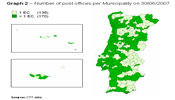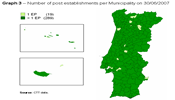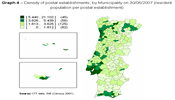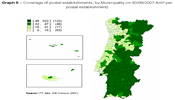At the end of the first half of 2007 there were 2,856 establishments in operation (see Graph 1), of which:
a) 919 permanent post offices (including 20 postal agencies1https://www.anacom.pt/render.jsp?contentId=55129);
b) 12 mobile post office2https://www.anacom.pt/render.jsp?contentId=55130;
c) 1925 postal service offices3https://www.anacom.pt/render.jsp?contentId=55131.
In comparison to the end of 2006, there has been a reduction of 7 postal establishments, consisting by a reduction of 29 post offices offset by an increase of 22 in the number of postal service offices.
As at the end of the first half of 2007, in 25 of these permanent post offices the customer service operations are contracted out in accordance with Base XXII, paragraph 1 of the Universal Postal Service Concession, giving a decrease of 7 compared to the 32 where these services were contracted out at the end of 2005. These post offices are generally designated as partnership shops4https://www.anacom.pt/render.jsp?contentId=55132.
As shown in Graph 1, there has been a continuous reduction in the number of postal establishments since 2002, resulting essentially from a reduction in the number of postal service offices.
Graph 1 - Evolution of the number of postal establishments

Click here to see the full-size image
In respect of post offices, at the end of the first half of 2007:
a) There was at least one post office located in every Municipality (Concelho) (see Graph 2);
b) In 138 Municipalities (45% of the total number of Municipalities) there was only one post office, three additional Municipalities (Peso da Régua, Vale de Cambra and Vinhais) since the end of 2006.
Graph 2 - Number of post offices per Municipality on 30/06/2007

Click here to see the full-size image
Considering the entire network of postal establishments (that is including the network of post offices and postal service office), at the end of the first half of 2007:
a) In 19 Municipalities there was only one postal establishment, corresponding to 6% of the 308 Municipalities in Portugal; in the remaining Municipalities there was more than one postal establishment (see Graph 3);
Graph 3 - Number of post establishments per Municipality on 30/06/2007

Click here to see the full-size image
b) On average, each postal establishment serviced 3,626 inhabitants. Density was highest in the regions of Aveiro, Faro, Lisboa, Porto, Santarém and Setúbal, in line with the population of the territory (see Graph 4). A figure above the national average was also recorded in certain Municipalities of the Autonomous Region of the Azores, the Autonomous Region of Madeira and the District of Bragança, among others;
Graph 4 - Density of postal establishments, by Municipality on 30/06/2007
(resident population per postal establishment)

Click here to see the full-size image
c) On average it is possible to find one postal establishment for every 32 km2. In the interior regions of the North and Centre and Sul do Tejo, as well as on the islands of Santa Maria, São Miguel, Terceira, São Jorge, Pico, Faial and Flores in the Autonomous Region of the Azores, there is a higher level of postal coverage (km2 per postal establishment) - Graph 5;
d) The percentage of Parishes (Freguesias) with at least one PE is 53%, corresponding to 2,235 Parishes (4 more Parishes than at the end of 2006), taking into account a total of 4,241 Parishes (2001 Census). It is further shown that the Parishes with at least one PE and which have less than 1000 inhabitants corresponds to 28% (610 Parishes; 611 at the end of 2006). Meanwhile, the percentage of Parishes with 1000 or more inhabitants and with at least one PE corresponds to 78% (1,625 Parishes; 1,620 at the end of 2006).
Graph 5 - Coverage of postal establishments, by Municipality on 30/06/2007
(km2 per postal establishment)

Click here to see the full-size image
According to CTT, all post offices provide the full range of concession service and 46% do not offer parcel services, while providing the remaining concession services.
-----
1 Postal agencies are postal establishments which are the same as post offices in physical terms and in terms of the level of postal services provided to users and customers, being different from post offices only in terms of the internal organisation of CTT, given that these are establishments which depend, in terms of hierarchical structure, on offices (Source: CTT)
2 Mobile post offices are postal establishments installed in automobile vehicles which follow previously defined routes and which stop in specific areas not served by permanent offices. The services provided are the same as those provided by fixed postal offices (Source: CTT).
3 Postal service offices are establishments, operated under contract by third parties. All of these offices provide the postal services which make up the universal service (Source: CTT).
4 Partnership shops are postal establishments with contracts made between CTT and another entity for the contracting out of the customer service operations in post offices. The postal services which make up the universal service are provided in the name of and behalf of CTT (Source: CTT).




